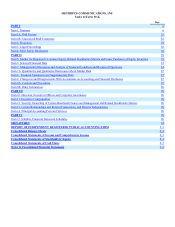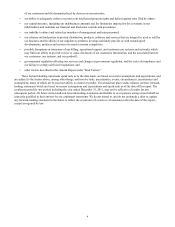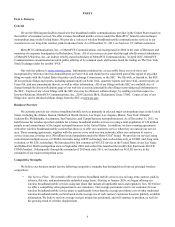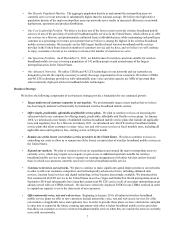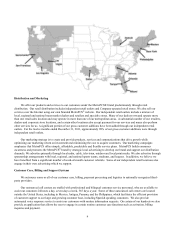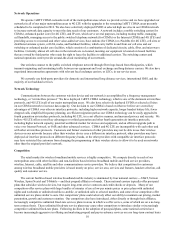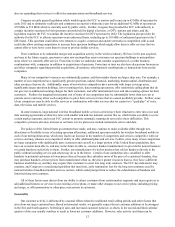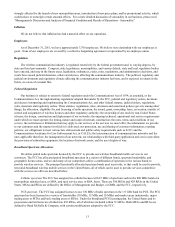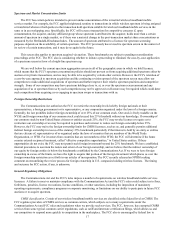Metro PCS 2011 Annual Report Download - page 21
Download and view the complete annual report
Please find page 21 of the 2011 Metro PCS annual report below. You can navigate through the pages in the report by either clicking on the pages listed below, or by using the keyword search tool below to find specific information within the annual report.10
Network Operations
We operate 1xRTT CDMA networks in all of the metropolitan areas where we provide service and we have upgraded our
networks in all of our major metropolitan areas to 4G LTE with the upgrades to the remaining 1xRTT CDMA areas presently
scheduled to be completed in 2012. We also have selectively deployed EVDO at selected high use sites in our CDMA network
to increase network data capacity to meet the data needs of our customers. A network includes a mobile switching center (for
CDMA), enhanced packet core (for 4G LTE), and IP core, which serve several purposes, including routing traffic, managing
call handoffs, managing access to the public switched telephone network (for CDMA) or the Internet (CDMA and 4G LTE) and
providing access to voicemail and other value-added services, base stations (for CDMA) or eNodeBs (for 4G LTE), cell sites or
distributed antenna system, or DAS, nodes, and backhaul facilities, which carry traffic to and from our cell sites and our
switching or enhanced packet core facilities, which consists of a combination of dedicated circuits, cable, fiber, and microwave
facilities. Currently, almost all cell sites in the network are co-located, meaning our equipment is located on leased facilities
that are owned by third parties who retain the right to lease the facilities to additional carriers. The switching centers and
national operations center provide around-the-clock monitoring of our network.
Our switches connect to the public switched telephone network through fiber rings leased from third-parties, which
transmit originating and terminating traffic between our equipment and local exchange and long distance carriers. We also have
negotiated interconnection agreements with relevant local exchange carriers, or LECs, in our service areas.
We currently use third-party providers for domestic and international long distance services, international SMS, and the
majority of our backhaul services.
Network Technology
Communications between the customer wireless device and our network is accomplished by a frequency management
technology, or “air interface protocol.” We have deployed 1xRTT CDMA technology, which is one of the dominant air interface
protocols, and 4G LTE in all of our major metropolitan areas. We also have selectively deployed EVDO at selected cell sites
on our CDMA network to increase data capacity. Our decision to use CDMA is based on what we believe are several key
advantages of CDMA over other air interface protocols, including higher network capacity, longer handset battery life, fewer
dropped calls, simplified frequency planning, an efficient migration path as our CDMA technology can be easily upgraded to
fourth generation air interface protocols, including 4G LTE, in a cost effective manner, and increased privacy and security. We
believe 4G LTE offers several key advantages over third generation and other fourth generation air interface protocols,
including higher network capacity, potential worldwide market for devices and equipment, and an efficient upgrade path to
voice over Internet Protocol, or VoIP, and other advanced services. CDMA and 4G LTE are incompatible with each other and
with other air interface protocols. Customers and former customers of other providers may not be able to use their wireless
devices on our networks because either their wireless device uses a different air interface protocol, other providers may have
deployed air interface protocols on different frequency bands, or the other providers with compatible air interface protocols
may have restricted the customers from changing the programming of their wireless device to allow it to be used on networks
other than the original provider's network.
Competition
The retail market for wireless broadband mobile services is highly competitive. We compete directly in each of our
metropolitan areas with other facilities and non-facilities based wireless broadband mobile and fixed service providers,
wireline, Internet, cable, satellite and other communications service providers. We believe that competition for customers
among wireless broadband mobile providers is based mostly on price, service area, services and features, handset selection, call
quality and customer service.
The current facilities-based wireless broadband mobile industry is dominated by four national carriers -- AT&T, Verizon
Wireless, Sprint Nextel and T-Mobile -- and their prepaid affiliates or brands. These national carriers typically offer post-paid
plans that subsidize wireless devices, but require long-term service contracts and credit checks or deposits. Many of our
competitors offer service plans with large bundles of minutes of use at low per minute prices or price plans with unlimited
nights and weekends or unlimited mobile-to-mobile, or unlimited calls to selected numbers, and some of our competitors offer
unlimited service plans similar to ours. Our competitors' plans could adversely affect our ability to maintain our pricing, market
penetration, growth and customer retention. Our competitors also have introduced, either directly or through their affiliates,
increasingly competitive unlimited fixed-rate services plans in areas in which we offer service, some of which are on a no long-
term contract basis. These unlimited fixed-rate service plans may cause other competitors to introduce similar or increasingly
competitive unlimited fixed-rate plans. Following declines in the adoption of post-paid plans, some national carriers have
become increasingly aggressive in offering and marketing prepaid and pay-in-advance services on a no long-term contract basis


